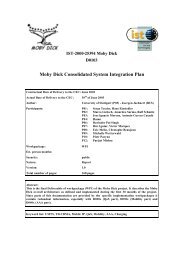j - AGH University of Science and Technology
j - AGH University of Science and Technology
j - AGH University of Science and Technology
You also want an ePaper? Increase the reach of your titles
YUMPU automatically turns print PDFs into web optimized ePapers that Google loves.
Piotr Chołda, Andrzej Jajszczyk<br />
As a numerical example, we compare three different protection topologies:<br />
three working connections with the same availabilities are to be protected. The<br />
following schemes are compared: the 1:3 protection; the topology in which each<br />
working path has its own protection path, it is in fact the 1+1 protection applied<br />
three times (six paths in total); <strong>and</strong> the 3:3 protection (three protection paths shared<br />
by three working paths). The analytical formula for the last case is rather complex,<br />
so we do not present it here. It is based on the 3-out-<strong>of</strong>-6 structure. The relevant<br />
formulas <strong>and</strong> comprehensive information how to calculate them can be found in<br />
[9]. The results are presented in Fig 5. We can see that the 1:3 protection results in<br />
a large increase <strong>of</strong> the availability in relation to unprotected connections. The gain<br />
is especially visible in the case when availabilities <strong>of</strong> the working paths are small<br />
(even if availabilities <strong>of</strong> protection paths are relatively low). It is the least reliable<br />
but the most cost efficient scheme <strong>of</strong> the three compared. Moreover, from the<br />
reliability point <strong>of</strong> view, the most favorable is the 3:3 protection, even better than<br />
applying the 1+1 protection for each working path separately. The reason is that in<br />
the case <strong>of</strong> 3:3 protection the scheme is more flexible. When one <strong>of</strong> the working<br />
paths fails, the traffic is rerouted on the protection path. And again, when this path<br />
fails, the traffic can be rerouted again. It is impossible in the case <strong>of</strong> the 1+1<br />
protection. However, we have to remember that the gain is minimal <strong>and</strong> practically<br />
such a solution could not be advantageous: it is, after all, necessary to use<br />
additional switching elements. Some analyses [10] indicate that the influence <strong>of</strong><br />
switching nodes cost on the total expenditure can be quite large. It seems that this<br />
fact is <strong>of</strong>ten neglected <strong>and</strong> optimization based only on the link cost could be<br />
insufficient.<br />
5. RESTORATION<br />
Unlike in the case <strong>of</strong> a protection, where an alternative path is established<br />
before a failure, in the case <strong>of</strong> the restoration such a path is sought after the fault<br />
notification. It makes the calculation <strong>of</strong> the availability more difficult. For example,<br />
the availability is calculated not for connections, but for carried traffic. Therefore,<br />
it is called the availability <strong>of</strong> a load ( A ). The authors <strong>of</strong> [4] propose the<br />
following formula for calculating it in a restoration scheme:<br />
M ⎛ CRec<br />
⎞ 1<br />
A = − ∑ ( ) × ⎜ ⎟<br />
Load 1 P Sceni<br />
⎜<br />
1−<br />
⎟<br />
(6)<br />
i= 1 ⎝ CT<br />
⎠<br />
where P ( Sceni<br />
) is the probability <strong>of</strong> failure scenario i (out <strong>of</strong> M scenarios); C T is<br />
the total capacity <strong>of</strong> traffic (sum <strong>of</strong> all working capacities); is the total<br />
capacity <strong>of</strong> the connections recovered upon failure scenario number i (this capacity<br />
includes also capacities <strong>of</strong> connections unaffected by a failure).<br />
Load<br />
C Rec<br />
i

















